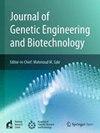Anther-mediated haploid induction and genetic stability of Phytophthora-resistant backcross lines of Capsicum annuum L
IF 2.8
Q3 Biochemistry, Genetics and Molecular Biology
Journal of Genetic Engineering and Biotechnology
Pub Date : 2025-05-09
DOI:10.1016/j.jgeb.2025.100498
引用次数: 0
Abstract
Bell pepper is an important vegetable crop from Solanaceae family, which is cultivated and consumed globally due to its delicious, pleasant and nutrient-rich nature. Most of the commercially cultivated bell pepper cultivars are however, highly susceptible to P. capsici. They are recalcitrance to in vitro regeneration, which make the crop improvement efforts difficult through plant tissue culture-based approaches such as double haploid production. In this study, in vitro callus regeneration protocol was established from anthers of two Phytophthora resistant-backcross lines derived from crossing of two highly susceptible bell pepper cultivars (California Wonder and Solan Bharpur) with a highly resistant chilli landrace, CM334.The cultures were initially established in full strength MS medium, supplemented with different concentration of auxin and cytokinin. Maximum callus induction was achieved in MS medium CI2 supplemented with IAA (2 mg/L) and BAP (0.3 mg/L) (41.59 %) at pH 5.8, without heat-shock and cold stress treatments. The light-green and white compact calli were obtained which proliferated and maintained in the half strength MS medium containing 0.1 mg/L Kinetin (pH 5.8). The presence of Phytophthora resistance loci and successful crossings were confirmed through PCR amplification with the closely linked (RGA-C) and pungency −specific (Pun2) molecular markers, and phenotypic evaluations against P. capsici. The haploid nature and genetic stability were revealed through squash staining with 2 % acetocarmin. This study standardized the conditions appropriate for double haploid culture and regeneration of whole plants to speed up the development of Phytophthora-resistant bell pepper varieties.
辣椒抗蚜回交系的花药介导单倍体诱导及其遗传稳定性
甜椒是茄科重要的蔬菜作物,因其美味宜人、营养丰富而在全球范围内广泛种植和消费。然而,大多数商业栽培的甜椒品种对辣椒粉非常敏感。它们难以在离体再生,这使得以植物组织培养为基础的双单倍体生产等作物改良工作变得困难。本研究利用两个高易感甜椒品种(California Wonder和Solan Bharpur)与高抗性辣椒地方品种CM334杂交而成的两个抗疫回交品系的花药,建立了离体愈伤组织再生方案。培养最初建立在全强度MS培养基中,补充不同浓度的生长素和细胞分裂素。在不进行热休克和冷胁迫处理的条件下,添加IAA (2mg /L)和BAP (0.3 mg/L)(41.59%)的MS培养基CI2在pH为5.8时愈伤组织诱导效果最好。在含有0.1 mg/L Kinetin (pH 5.8)的半强度MS培养基中,获得了浅绿色和白色致密愈伤组织,并能增殖和维持。通过紧密连锁(RGA-C)和辛辣特异性(Pun2)分子标记的PCR扩增,以及对辣椒疫病的表型评价,证实了疫霉抗性位点的存在和成功杂交。用2%乙酰卡明对南瓜进行染色,揭示了其单倍体性质和遗传稳定性。本研究规范了双单倍体培养和整株再生的适宜条件,以加快培育抗蚜甜椒品种。
本文章由计算机程序翻译,如有差异,请以英文原文为准。
求助全文
约1分钟内获得全文
求助全文
来源期刊

Journal of Genetic Engineering and Biotechnology
Biochemistry, Genetics and Molecular Biology-Biotechnology
CiteScore
5.70
自引率
5.70%
发文量
159
审稿时长
16 weeks
期刊介绍:
Journal of genetic engineering and biotechnology is devoted to rapid publication of full-length research papers that leads to significant contribution in advancing knowledge in genetic engineering and biotechnology and provide novel perspectives in this research area. JGEB includes all major themes related to genetic engineering and recombinant DNA. The area of interest of JGEB includes but not restricted to: •Plant genetics •Animal genetics •Bacterial enzymes •Agricultural Biotechnology, •Biochemistry, •Biophysics, •Bioinformatics, •Environmental Biotechnology, •Industrial Biotechnology, •Microbial biotechnology, •Medical Biotechnology, •Bioenergy, Biosafety, •Biosecurity, •Bioethics, •GMOS, •Genomic, •Proteomic JGEB accepts
 求助内容:
求助内容: 应助结果提醒方式:
应助结果提醒方式:


